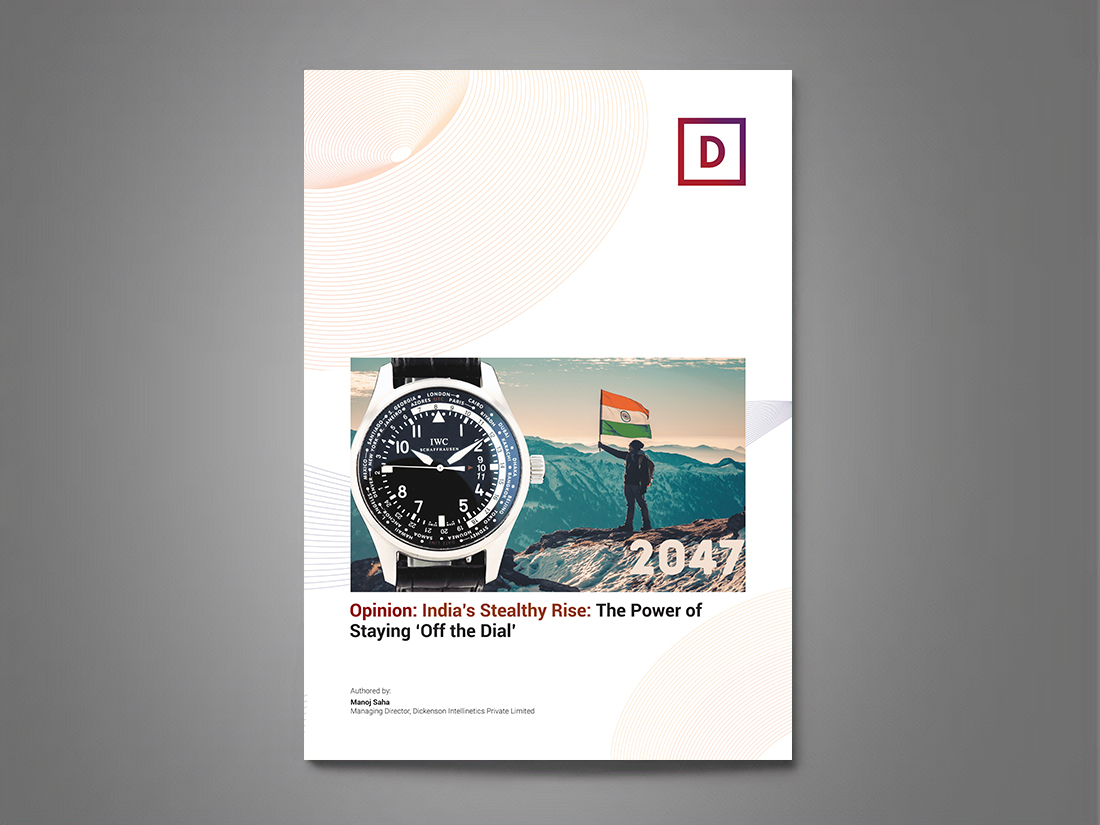Opinion:
India’s Stealthy Rise:
The Power of Staying ‘Off the Dial’
How being ‘off the dial’ is helping India outmanoeuvre the global order
The world’s great cities tick across the dials of luxury world-time watches-New York, London, Tokyo, Paris, Hong Kong. Even Karachi and Dhaka make the cut. But India? Nowhere to be found. Despite being the world’s most populous country and the fifth-largest economy, its unique 30-minute time offset (UTC+5:30) means it doesn’t quite fit the clean symmetry of the 24-hour global standard.
Yet, India’s absence from the gilded faces of Rolex and Omega is oddly fitting. It has mastered the art of being everywhere and nowhere at the same time—growing, rising, influencing, yet rarely attracting the kind of scrutiny that forces a reckoning. Like a stealth aircraft evading radar, India has positioned itself outside the world’s fixed coordinates, advancing its interests while remaining just blurry enough to avoid direct confrontation.
The Fine Art of Being Present, Yet Absent
This strategic invisibility is no accident. India has long been omitted from the world’s power structures—most notably the United Nations Security Council, where it remains an aspirant rather than a permanent member. But while New Delhi occasionally grumbles about UNSC reform, it has quietly redirected its diplomatic capital into shaping new, more fluid arenas of influence. The G20 presidency, where India deftly inserted itself as the voice of the Global South, is a case in point. While larger powers squabbled, India played the host, the mediator, and the consensus-builder, all while burnishing its economic credentials.
“Like a stealth aircraft evading radar, India has positioned itself outside the world’s fixed coordinates—advancing its interests while remaining just blurry enough to avoid direct confrontation.”
The same pattern holds in trade. When Donald Trump went on a tariff warpath against China, India wasted no time recalibrating its own trade policies—modestly lowering some barriers to avoid America’s ire while slipping into supply chains disrupted by U.S.-China tensions. There were no grand pronouncements, no self-congratulatory declarations—just quiet, strategic adjustment.
Even on geopolitics, India has glided through crises with enviable dexterity. Its carefully worded “This is not an era of war” stance on Ukraine allowed it to maintain trade ties with Russia while keeping the West sufficiently reassured. At a time when European capitals wanted a firm alignment, India instead performed a diplomatic slalom—condemning civilian casualties, backing territorial integrity, but never fully severing its Moscow connection. The result? India continued buying discounted Russian oil while expanding its economic partnerships with the EU and the U.S.
“India’s semi-invisibility is a tactical advantage. While other nations find themselves locked into rigid alliances and antagonisms, India moves with agility, making itself indispensable without being confrontational.”
Why ‘India’s Rate of Growth’ Is Better Than China’s Sprint
Unlike China’s explosive, debt-fuelled sprint to double-digit growth, India’s 6-7% trajectory seems almost deliberately paced—fast enough to attract investment, yet not so overheated as to risk the property bubbles, bad debt, and demographic headwinds now haunting Beijing. Manufacturing is rising without excessive leverage, digital infrastructure is expanding without investor-scaring crackdowns, and India’s demographic dividend remains flexible, unshackled by rigid political structures.
“Unlike China’s explosive, debt-fuelled sprint, India’s 6-7% growth is almost deliberately paced—fast enough to attract investment, yet not so overheated as to risk the bubbles and distortions now haunting Beijing.”
Some worry that India might grow old before it grows rich, but a steady pace makes this less of a crisis and more of an inevitability to be managed wisely. While China raced to prosperity only to face a demographic cliff, India’s slower transition allows for organic adjustments—building social safety nets, strengthening healthcare, and gradually shifting toward a more productivity-driven economy. By the time India does age, it will have built a resilient middle class, rather than relying on unsustainable, debt-heavy development. Ultimately, it’s not about how fast India gets rich—it’s about ensuring it gets there without the structural distortions that now threaten its rivals.
Even some of the world’s most advanced economies are discovering that wealth on paper does not always translate to resilience. The U.S. and much of Europe are grappling with mounting debt, aging populations, and stagnant productivity—challenges that make their dominant positions in the global pecking order increasingly difficult to sustain. Japan, once the poster child of economic ascendancy, has spent decades struggling under the weight of its own overleveraging. Even China, despite its economic might, now faces a slowdown driven by structural imbalances. These nations may still be rich, but they are also increasingly burdened—forced to funnel more resources into servicing debt, propping up social security systems, and maintaining their global influence with less economic firepower than before. India, by contrast, has yet to inherit these burdens, giving it room to grow without the liabilities that are now weighing down the old guard.
The Power of Staying Off the Dial
Being left off the world’s timepieces may seem like an oversight—an omission unbefitting a nation of India’s scale and influence. But in an era where visibility often invites scrutiny, rivalry, and confrontation, India’s semi-invisibility is not a weakness—it is a carefully honed advantage. While other nations find themselves bound by rigid alliances, forced into binary choices of allegiance or opposition, India moves with quiet agility, engaging where it benefits, disengaging where it must, and always retaining the flexibility to recalibrate.
Where India reaches by 2047—its centenary of independence—is, in many ways, an academic question. Growth projections, GDP targets, and global rankings make for compelling debates, but the real measure of success lies not in arbitrary milestones but in the resilience and adaptability of the nation’s trajectory. A $10 trillion economy sounds impressive, but what will matter more is whether that growth is broad-based, inclusive, and sustainable. Will India have built institutions strong enough to weather global shocks? Will its workforce be equipped for the industries of the future? Will its cities be liveable, its resources managed wisely, its influence wielded with strategic foresight? The exact numbers may fluctuate, but if India continues its current path—balancing ambition with pragmatism, growth with stability—it will not be defined by where it stands in 2047, but by the foundations it lays for the century beyond.
Like a masterful chess player who thrives in the middle game rather than rushing toward an aggressive checkmate, India is steadily positioning itself without triggering the kind of reactions that derail long-term strategy. It is neither a loud disruptor nor a passive bystander—it is the quiet orchestrator of its own ascent.
Perhaps, then, it is only fitting that world timers omit India. Because in the grander schemes of geopolitics and global economics, India has no need to conform to preset increments. It is not following the world’s time. It is setting its own.
Contact Us: To learn more or schedule a consultation, please reach out to us at www.dickensonworld.com
Email:enquiry@dickensonworld.com.
About the Author
With over 25 years of experience in corporate finance and a deep-rooted understanding of ESG imperatives, Manoj Saha brings a wealth of knowledge to the discourse on corporate governance. Educated in the UK in Accountancy & Finance, he has dedicated his career to guiding organizations through the intricacies of financial management and stakeholder engagement across global markets, including India, the USA, the UK, and the Middle East and North Africa (MENA) region.

Opinion India’s Stealthy Rise
To download and save this article.
Authored by:
Manoj Saha
Managing Director, Dickenson World
Visit www.dickensonworld.com to learn more about our services and how we can help streamline your corporate reporting process.


Leave A Comment